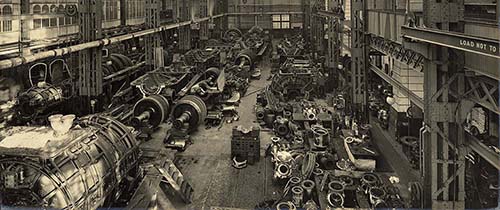John Brown's
By Ian Johnstone
Clydebank shipyard, for a time known as John Brown & Co, was probably the most significant shipyard in the world. From its slipways were launched more internationally important vessels than from any other yard.
The shipyard had its origins in the Finnieston area of Glasgow in 1847, when two brothers, James and George Thomson, established a marine engine-building business at the Clyde Bank Foundry. Both James and George had worked under the pioneering engineer and entrepreneur, Robert Napier, who did much to introduce marine engineering and iron shipbuilding to the Clyde. James and George earned a reputation for building reliable steam engines and by 1851 they decided to expand the business by setting up a shipyard at Bankton to the east of Govan where they laid out a shipyard covering 5 acres.
Pictured above is the erecting shop in the engine works John Brown's Clydebank Shipyard, photographed c. 1910.
